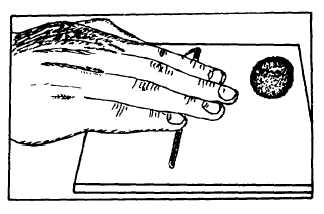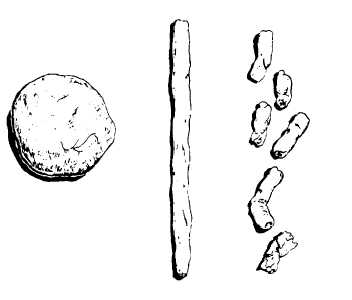Figure 15-38.-Roll or thread test.
fingers and the test board (fig. 15-38) with just
enough pressure to roll the mass into a thread of
uniform diameter throughout its length. The rate
of rolling should be between 80 and 90 strokes
a minute, considering a stroke to be one complete
motion of the hand forward from and back to
the starting point.
2. When the diameter of the thread has been
reduced to 1/8 in., break the thread into six or
eight pieces (fig. 15-39). Squeeze the pieces
together between the thumbs and fingers of both
hands into a uniform mass roughly oval in shape,
and again roll out into a thread. Continue this
alternate rolling to a thread 1/8 in. in diameter,
breaking, combining together, and rerolling. Do
this until the thread crumbles under the pressure
required for rolling and the soil can no longer be
rolled into a thread. The crumbling may occur
when the diameter of the thread is still greater than
1/8 in. This is considered a satisfactory end point,
provided the soil has previously been rolled into
a 1/8-in. thread at least once.
3. Gather the portions of the crumbled soil
together, place it in the moisture content can, and
determine the water content from the difference
in weight before and after you oven-dry it.
4. Repeat the process on at least two addi-
tional specimens. All three tests should agree
within 1 percent.
The plastic limit is simply the determined water
content.
Plasticity Index
The PLASTICITY INDEX (PI) of a soil is the
numerical difference between its liquid limit and
its plastic limit; that is, PI = LL – PL. The PI
that appears in figure 15-37 means plasticity index.
Figure 15-39.-Roll or thread test sample, before and after
crumbling.
CONCRETE TESTING
Before delving into the remainder of this
chapter, you may find it helpful to return to
chapter 7 and review the topics concerning con-
crete. As you recall, in that chapter you studied
concrete in terms of its use as a construction
material, and you learned of the properties and
requirements that comprise a good concrete. You
also know that when concrete is placed in the field
on a construction project, the concrete used must
satisfy certain specified requirements. It is towards
those properties and various requirements that
concrete testing is directed.
CONCRETE TESTS
In concrete testing, as in soils testing, no single
test will provide all of the information required.
Rather, there is an array of tests that must be per-
formed. The following describes those tests with
which an EA is most commonly concerned.
Aggregate Tests
In order to provide the strongest and most
durable concrete, the aggregate contained in the
mixture must be the best possible in terms of
gradation, shape, strength, and cleanliness.
During the design of a concrete mixture, the
aggregate selected for use must adequately meet
those requirements. To determine this, various
tests are performed. These include tests for
15-34



